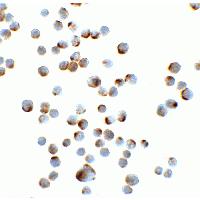GAPDH Chicken Polyclonal Antibody
CAT#: TA349011
Chicken Polyclonal Anti-GAPDH Antibody
Need it in bulk or conjugated?
Get a free quote
CNY 5,808.00
| Cited in 1 publication. |
CNY 3,080.00
CNY 300.00
CNY 1,430.00
CNY 2,900.00
CNY 9,998.00
Specifications
| Product Data | |
| Applications | IF, WB |
| Recommend Dilution | WB: 1 ug/mL |
| Reactivity | Human, Mouse, Rat |
| Host | Chicken |
| Clonality | Polyclonal |
| Immunogen | GAPDH antibody was raised against a 16 amino acid synthetic peptide from near the carboxy terminus of human GAPDH. The immunogen is located within amino acids 230 - 280 of GAPDH. |
| Formulation | PBS containing 0.02% sodium azide. |
| Concentration | 1 mg/ml |
| Purification | GAPDH Antibody is affinity chromatography purified via peptide column. |
| Conjugation | Unconjugated |
| Storage Condition | Store at -20°C as received. |
| Gene Name | glyceraldehyde-3-phosphate dehydrogenase |
| Database Link | |
| Background | GAPDH Antibody: Glyceraldehyde-3-phosphate dehydrogenase (GAPDH) catalyzes the reversible oxidative phosphorylation of glyceraldehyde-3-phosphate in the presence of inorganic phosphate and nicotinamide adenine dinucleotide (NAD), an important energy-yielding step in carbohydrate metabolism. Recent evidence suggests that it also is involved in a number of cellular processes such as membrane fusion, phosphotransferase activity, DNA replication and repair, and nuclear RNA export. GAPDH has also been implicated in playing a role in different pathologies such as cancer progression, apoptosis, and neuronal diseases such as Alzheimer's and Huntington's disease. GAPDH is constitutively expressed at high levels in almost all tissues and cell lines making it ideal for use as a loading control marker in immunoblots. |
| Synonyms | G3PD; GAPD; HEL-S-162eP |
| Reference Data | |
| Protein Families | ES Cell Differentiation/IPS |
| Protein Pathways | Alzheimer's disease, Glycolysis / Gluconeogenesis, Metabolic pathways |
Citations (1)
| The use of this Antibodies has been cited in the following citations: |
|---|
|
Ghrelin receptors in rat and human nodose ganglia: putative role in regulating CB-1 and MCH receptor abundance.
,null,
American journal of physiology. Gastrointestinal and liver physiology
,PubMed ID 16423919
[GAPDH]
|
Documents
| Product Manuals |
| FAQs |
| SDS |
Resources
| 抗体相关资料 |


 United States
United States
 Germany
Germany
 Japan
Japan
 United Kingdom
United Kingdom
 China
China


